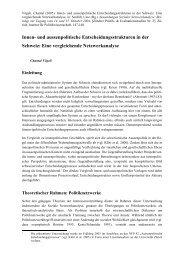Assessing Structure from Process: The Actor-Process-Event Scheme
Assessing Structure from Process: The Actor-Process-Event Scheme
Assessing Structure from Process: The Actor-Process-Event Scheme
You also want an ePaper? Increase the reach of your titles
YUMPU automatically turns print PDFs into web optimized ePapers that Google loves.
Step 10: Visualize Network<br />
ACTOR-PROCESS-EVENT SCHEME - APES<br />
APES provides a visualization feature that transforms a scheme into a sociogram,<br />
visualized as a target diagram. Within a target diagram all nodes are arranged according to a<br />
specific attribute, usually it is a centrality measure. Each node is then placed on a distinct<br />
radius, whereas the node with the highest centrality value is placed close to the centre, and the<br />
ones with low centrality measures are arranged on the periphery of the target diagram. In the<br />
current version of APES, the target diagram is plotted by the use of Bonacich’s eigenvector<br />
centrality (Bonacich 1972). With eigenvector centrality, a node is considered as central, if it is<br />
directly connected to other nodes who are central as well.<br />
For the calculation of eigenvector centrality, APES extracts an actor-event matrix <strong>from</strong><br />
the scheme and transforms it into a one-mode actor-actor matrix. <strong>The</strong> program then computes<br />
eigenvector centrality for each actor and runs an algorithm through the calculated centralities,<br />
which assigns each actor a radius according to its centrality measure. <strong>The</strong> network is then<br />
plotted as the target diagram.<br />
Step 11: Export and import files <strong>from</strong>/ to other software applications<br />
For further network calculations, APES files can be exported to other software<br />
applications such as Ucinet (Borgatti et al. 2002). APES generates both an actor-event matrix<br />
and an actor-actor matrix, derived <strong>from</strong> the scheme itself. <strong>The</strong> matrices are saved as text-files<br />
(csv), which can be exported into other software applications.<br />
21



